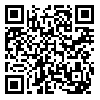BibTeX | RIS | EndNote | Medlars | ProCite | Reference Manager | RefWorks
Send citation to:
URL: http://mjiri.iums.ac.ir/article-1-2880-en.html
Background: CT scan and nuclear medicine exams deliver a great part of medical exposures. This study examined professional radiation hazards in CT scan and nuclear medicine workers.
Methods : In a cross sectional study 30 occupationally exposed workers and 7 controls (all from personnel of a laboratory) were selected. Physical dosimetry was performed for exposed workers. Blood samples were obtained from the experimental and control groups. Three culture mediums for each one were prepared in due to routine chromosome analysis using G-banding and solid stain.
Results : There were significant increased incidence of chromatid gap (ctg) and chromatid break (ctb) with mean±SD frequencies of 3±0.84 and 3.1±1.40 per 100 cells respectively in the nuclear medicine workers versus controls with mean±SD frequencies of 1.9±0.69 and 1.3±0.84 for ctg and ctb, respectively. Chromosome gaps (chrg) were higher significantly in the nuclear medicine population (2.47±0.91) than in controls (1.4±0.9) (p<0.05). In CT scan group the ctg and ctb were increased with a mean±SD frequency of 2.7±0.79 and 2.6±0.91 per 100 cells respectively compared with control group. The mean±SD frequencies of the chrb were 2.0±0.75 and 0.86±0.690 per 100 cells for exposed workers and control group, respectively.
Conclusion : This study showed chromosome aberrations in peripheral lymphocytes using solid stain method are reasonable biomarker reflecting personnel radiation damage.
| Rights and permissions | |
 |
This work is licensed under a Creative Commons Attribution-NonCommercial 4.0 International License. |





